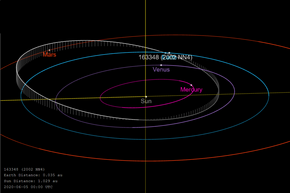(163348) 2002 NN4
 2002 NN4 orbits between Venus and Mars | |
| Discovery[1] | |
|---|---|
| Discovered by | LINEAR |
| Discovery site | Lincoln Lab's ETS |
| Discovery date | 9 July 2002 |
| Designations | |
| (163348) 2002 NN4 | |
| 2002 NN4 | |
| NEO · PHA · Aten[1][2] | |
| Orbital characteristics[2] | |
| Epoch 31 May 2020 (JD 2459000.5) | |
| Uncertainty parameter 0[2] · 2[1] | |
| Observation arc | 14.16 yr (5,171 d) |
| Aphelion | 1.2572 AU |
| Perihelion | 0.4956 AU |
| 0.8764 AU | |
| Eccentricity | 0.4345 |
| 300 days | |
| 83.774° | |
| 1° 12m 4.68s / day | |
| Inclination | 5.4177° |
| 259.48° | |
| 222.23° | |
| Earth MOID | 0.0069 AU (2.69 LD) |
| Physical characteristics | |
Mean diameter | |
| 14.50±0.03 h[5][a] | |
| X[3] | |
| 20.1[1][2][4] | |
(163348) 2002 NN4 (prov. designation: 2002 NN4) is a dark, sub-kilometer near-Earth object and potentially hazardous asteroid of the Aten group that flew by Earth on 6 June 2020. The highly elongated X-type asteroid has a rotation period of 14.5 hours and measures approximately 0.7 kilometers (0.4 miles) in diameter.[2][6] It was discovered by LINEAR at the Lincoln Laboratory's Experimental Test Site in New Mexico on 9 July 2002.[1]
Orbit
2002 NN4 flew by Earth on 6 June 2020, passing 0.034 AU (5.1 million km; 13 LD) from Earth.[2] The asteroid had been recovered two days earlier on 4 June 2020.[1] By 11 June 2020, the asteroid had brightened to apparent magnitude 14.4, which is roughly the brightness of Pluto.
Being a member of the Aten asteroids, 2002 NN4 orbits the Sun at a distance of 0.50–1.26 AU once every 10 months (300 days; semi-major axis of 0.88 AU). Its orbit has an eccentricity of 0.43 and an inclination of 5° with respect to the ecliptic.[2] It was first observed by the Near-Earth Asteroid Tracking on Palomar Observatory on 2 July 2002, or seven nights prior to its official discovery observation by LINEAR.[1] This asteroid has an Earth minimum orbit intersection distance of 0.0069 AU (1,030,000 km), which corresponds to 2.7 lunar distances (LD).[2]
Physical characteristics
A spectroscopic survey of the small near-Earth asteroid population conducted by European astronomers determined that 2002 NN4 is an X-type asteroid.[3][6] Because of the objects low albedo (see below), it would be considered a primitive P-type asteroid in the Tholen classification.
Diameter and albedo
According to the survey carried out by the NEOWISE mission of NASA's Wide-field Infrared Survey Explorer, 2002 NN4 measures (735±243) meters in diameter, and its surface has a dark albedo of (0.030±0.027).[4] (The NEOWISE publication uses the designation G3348 for this asteroid.[7]) In 2016, astronomers using the European New Technology Telescope at La Silla Observatory found a diameter of 613 meters with an albedo of 0.047.[3]: 4
Rotation period
In August 2016, the first rotational lightcurve of 2002 NN4 was obtained from photometric observations over five nights by Brian Warner at the Center for Solar System Studies (U82) in California. Lightcurve analysis gave a rotation period of 14.50±0.03 hours with a high brightness variation of 0.74±0.05 magnitude, indicative of a highly elongated shape (U=3−).[5][a]
Notes
- ^ a b Lightcurve plot of (163348) 2002 NN4, by Brian Warner at the Center for Solar System Studies (2016). Rotation period of 14.50±0.03 hours with a brightness amplitude of 0.74±0.05 mag. Quality code is 3−. Summary figures at the LCDB and CS3 websites.
References
- ^ a b c d e f g "163348 (2002 NN4)". Minor Planet Center. Retrieved 8 June 2020.
- ^ a b c d e f g h "JPL Small-Body Database Browser: 163348 (2002 NN4)" (2016-08-28 last obs.). Jet Propulsion Laboratory. Retrieved 8 June 2020.
- ^ a b c d e Perna, D.; Barucci, M. A.; Fulchignoni, M.; Popescu, M.; Belskaya, I.; Fornasier, S.; et al. (August 2018). "A spectroscopic survey of the small near-Earth asteroid population: Peculiar taxonomic distribution and phase reddening". Planetary and Space Science. 157: 82–95. arXiv:1803.08953. Bibcode:2018P&SS..157...82P. doi:10.1016/j.pss.2018.03.008. ISSN 0032-0633. S2CID 119426280.
- ^ a b c d Masiero, Joseph R.; Nugent, C.; Mainzer, A. K.; Wright, E. L.; Bauer, J. M.; Cutri, R. M.; et al. (October 2017). "NEOWISE Reactivation Mission Year Three: Asteroid Diameters and Albedos". The Astronomical Journal. 154 (4): 10. arXiv:1708.09504. Bibcode:2017AJ....154..168M. doi:10.3847/1538-3881/aa89ec. S2CID 45334910.
- ^ a b Warner, Brian D. (January 2017). "Near-Earth Asteroid Lightcurve Analysis at CS3-Palmer Divide Station: 2016 July-September" (PDF). Minor Planet Bulletin. 44 (1): 22–36. Bibcode:2017MPBu...44...22W. ISSN 1052-8091. PMC 7243971. PMID 32455389.
- ^ a b "LCDB Data for (163348) 2002 NN4". Asteroid Lightcurve Database (LCDB). Retrieved 8 June 2020.
- ^ Plait, Phil (4 June 2020). "No, we're not in any danger from an asteroid passing Earth on Saturday night". Bad Astronomy. Retrieved 9 June 2020. (Neowise Table)
External links
- Stadium-size asteroid will safely fly by Earth tonight, Space.com
- Small Asteroid to Safely Fly by Earth, NASA
- Asteroid 163348, Small Body Data Ferret
- Discovery Circumstances: Numbered Minor Planets (160001)-(165000) – Minor Planet Center
- (163348) 2002 NN4 at NeoDyS-2, Near Earth Objects—Dynamic Site
- (163348) 2002 NN4 at the JPL Small-Body Database


